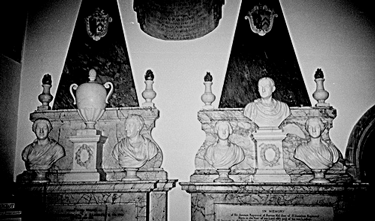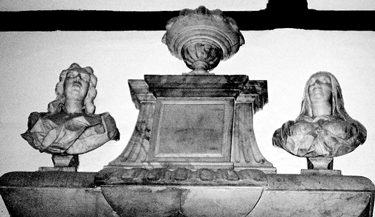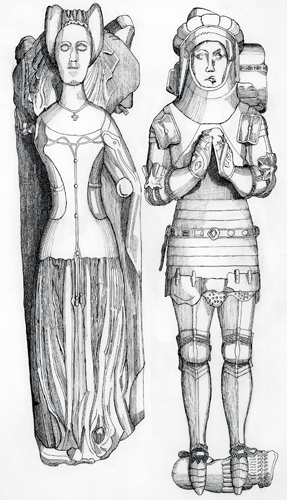 |
Aldworth - St Mary |
 |
| The church is open during
normal hours. You may park in the village or near the church
although space can be tight. O/S Ref: 554 794 First rate pub in the village - The Bell: the best cask ales and ciders, no music, no game machines, no television, no actual bar so easy to get served, many nooks - and the best sandwiches you've ever had. |
| These effigies represent members of the
de la Beche family,
lords of the manor in the 14th century, although it is not
possible to identify them individually. The effigies are very
mutilated but are never-the-less of great interest. Six of the
effigies lie under canopies against the north and south walls -
three on either side. These canopies were over restored by
Aubin
in 1817, although Earp did the actual carving. These monuments
date from the 1340's. The other three effigies, which are of a
similar date, although possible a little later, lie on tomb
chests under the arcading between the south aisle and nave. I made drawings of the effigies over a weekend several years ago and then prepared the etchings which are shown below. I took the photographs a few years later. |
| SOUTH WALL GROUP | ||||
| West | East | Central | ||
.jpg) |
.jpg)  |
.jpg) |
||
 |
|
 |
||
| CENTRAL GROUP | |
| West | East |
 .jpg)  .jpg)  |
|
 |
 |
 |
|
|
Another military effigy with armour of a slightly later fashion. He lies in a more conventional fashion with straight legs (although now mostly lost) and hands in prayer. His head rests on a helmet and he wears a pointed bascinet with what was probably a mail tippet, although again there is no carving, falling onto his shoulders. The arms are enclosed in plate of which the straps and joints can be seen. He wears a short surcoat, which is tightly laced above the waist and loose below. There are remains of a sword which is held be a thick belt with an elaborate buckle. Oolitic limestone. No slab; the effigy rest on a tomb chest of Purbeck marble slabs |
There
are two effigies here - an knight and a lady. They lie on a tomb
chest with bases of pillars at each corner, indicating that
there was perhaps once a canopy.
|
| NORTH WALL GROUP | |||
| Central | East | West | |
.jpg) |
.jpg) |
.jpg) |
|
 |
|||
 |
|
 |
|
It has been said above that it is not possible to identify these effigies with any certainly until further information is uncovered. However attempts has been made in the past to do so and it may be of interest to briefly mention this here. There is no surviving documentation, inscription or heraldry to enable positive indentification of these effigies. In 1883 Francis Llewleyn LLoyd, vicar of Aldworth from 1857, published his research as an attempt to identify the effigies, although two years later he appeared to become convinved that his identification was correct. He identified the NE effigy as Sir Philip (after 1335), founder of the new church; his wife - Lady Joan - was identified as the SC effigy. Two of their children were identified thus: Sir John (1326) is the CE effigy and Sir Nicholas (1346) the CW effigy; this may well be the other way round from an earlier discription by Richard Symonds in 1644 so that the lady CE would then be his wife Lady Isabella. The NW effigy was identified as Sir Robert (1278) and the NC effigy - his son and father of Sir Philip above - as Sir John (after 1287). The SW effigy was identified as another son of Philip and Joan, another Sir Philip (1339) and the SE effigy as Sir John (1336), son of Sir John and Lady Isabella. Make of it what you will! |
|||
| Ardington - Holy Trinity |
 Clarke Family 1635 |
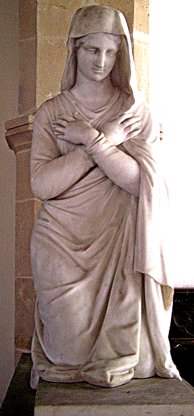 |
 |
 |
 |
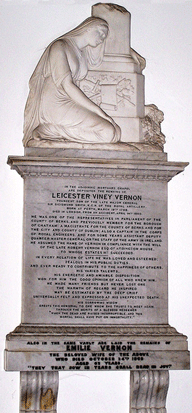 Leicester Viney Vernon and his wife Emilie |
| Left, Above Left &
Right and Right: Two monuments to
Robert Vernon (1849)
The kneeling lady is by
Baily |
|||||
| In the Churchyard |
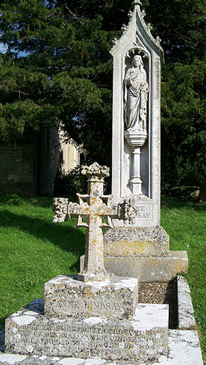 |
||
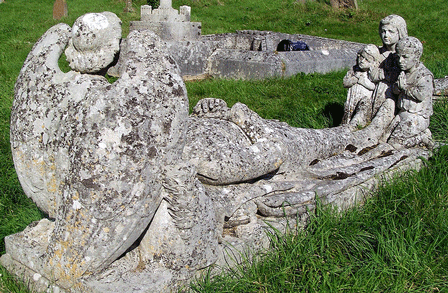 |
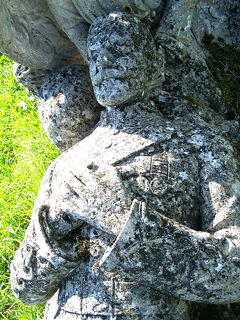 |
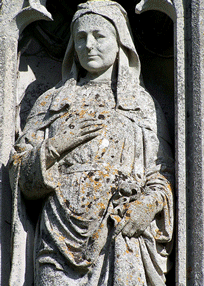 |
|
| Above Left & Centre:
Hamilton Lindsay, Earl of Crawford Above Right and Far Right: Ann Linsay (1894) wife of General James Lindsay |
|||
| Barkham - St James | Burghfield - St Mary |
Compton Beauchamp St Swithun |
.png) |
.png)
Knight
(1290-1325) wooden with cross legs. This
had been stolen when I visited the church in the 1970's. It
has since been recovered and I will revisit.
Knight/Lady (1410-1470) alabaster and very mutilated. Said to represent the Yorkist Richard Neville, Earl of Salisbury and his Countess; However recent thought believes the lady does not to belong, being an earlier Countess of Salisbury; because there are three possible candidates from this period, it has not been possible to identify her. (information from Jon Bayliss) |
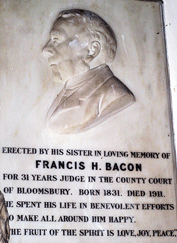
Francis H Bacon (1911) Judge. 'He spent all
his life in benevolent efforts to make all around him happy'
|
|
Lady (1250-1310) wood, very worn, in porch. |
| A Short Note on Richard Neville, Earl of Salisbury |
|
Salisbury was a Yorkist leader who was captured
by the Lancastrians after their victory at the Battle of
Wakefield in 1460, and confined in Pontefract castle. He was
then either executed or dragged out of the castle by the locals
and murdered. Richard, Duke of York, claimant to the
throne after whom the term Yorkist is named, was
also executed after the battle. Salisbury was initially buried at Pontefract but
following Yorkist control his body was transferred to Bisham
Abbey in Berkshire, which acted as the Neville mausoleum. At the
Dissolution of the Monasteries these effigies are said to the
been brought to Burghfield. The armour is of the right period and the Neville Arms can be faintly made out on the surcoat; however there is no inscription or more definite arms. This Richard Neville was the father of another Richard Neville, Earl of Warwick, know as the King Maker |
 |
Childrey - St Mary |
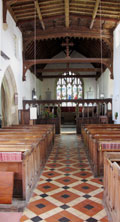 |
| Church open. Park outside O/S Ref: SU 360 878 |
 |
.png) |
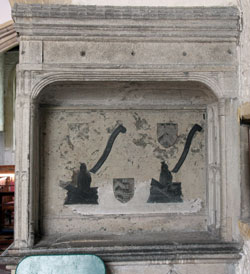 William Feteplace (1516) & his wife Elizabeth (Waring). The brasses, which are shown below, are set into the back wall of this Purbeck marble monument consisting of a short tomb chest and canopy. They gave money from their lands to maintain a priest, an alms house for three poor men and a school for the children of the parish. |
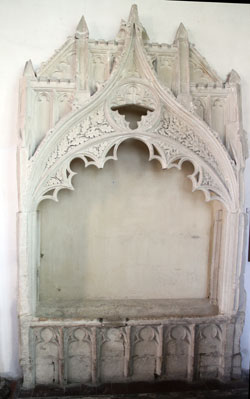 |
| Drawing and photograph of Knight of the early 14th century. A V B Norman reports heraldry.The effigy is set below floor level under a ogee arched recess | Tomb with canopy | ||
| Above: Tombs & Effigies Below: Brasses |
 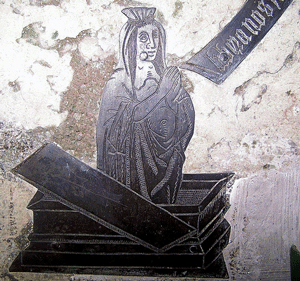 The Feteplace brasses referred to above; shrouded copses emerging from their graves |
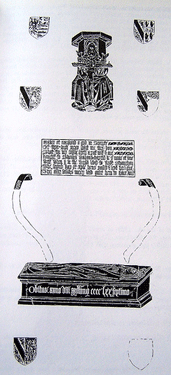 |
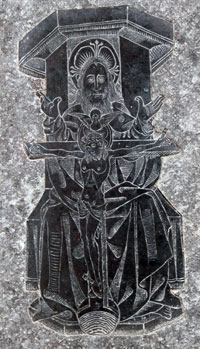 |
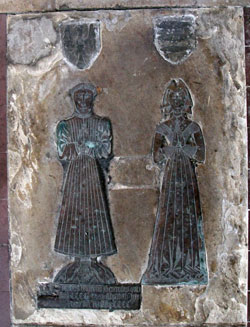 |
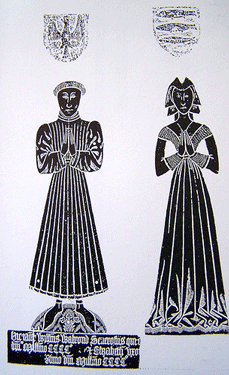 |
| Above and Right: Joan Strongbow (1477) daughter of Thomas Waldrond. English inscription . South transept floor |
 |
Above: William Waldrond (c 1480) & Elizabeth (Roches) Inscription | ||
 |
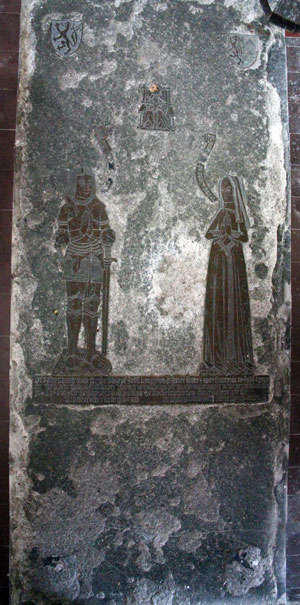 Left & above: John Kyngeston (1514) & Susan (daughter of Richard Fetyplace of East Shefford) She is buried at Shalston, Bucks where she is depicted as a widow/vowess on her brass there. English inscription. Chancel floor |
 |
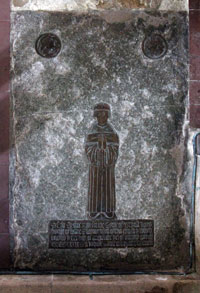
Left & Above: Priest
in mass vestments ? William Knight Rector (c 1480)
|
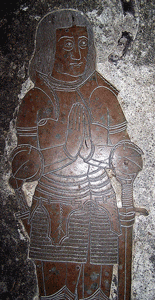
 |
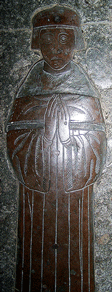 Bryan Roos LLD (1529) Parson English inscription |
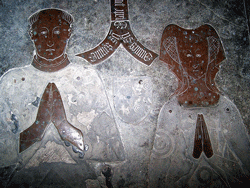 Above: William Fynderne (1444) & Elizabeth (daughter of Thomas Chelry and widow of John Kyngeston) fragmentary, English inscription, Chancel floor |
 Thomas (1480) & Alice (1477) Waldrond English inscription |
 |
Cookham - Holy Trinity |
 |
 |
 |
| Left: Robert Peak (1517), and his wife, Agnes; there are brasses on the tomb chest which are not easily seen in the photograph. Purbeck marble; it has been dismantled at some point and rather carelessly reassembled. He was Clerk of the Spicery to King Henry VI. Top left: Arthur Babham (1561) and his unnamed wife, two sons and three daughters. Above right: Sir Isaac Pocock (1810) who drowned in the Thames. By Flaxman | ||
| Other Monuments |
| John Brabham (1458) and inscription. Brass. There is also a matrix of a female figure in the stone, Probably his wife, Muriel. |
| William Andrew ( 1503), John Monkedon, and Margaret. Brass. Possible wife and two husbands. |
| Richard Brabham (1527) Brass with kneeling effigies of him and his unnamed wife. |
| Edward Wooyore (1615) Brass to him and his unnamed wife (1613). Inscription. |
| George Welldon (1611) Brass |
| Maria Farmer (1645) Brass |
| George Weldon (1649) Slab with inscription in Latin; set in later moulded frame. Wall mounted? |
| There are several later floor slabs to the Weldon family. |
| Noah Barnard (1655), his daughter, Mary (1691) and his wife, Anne (1717) Floor slab |
| Dorothy Sivedail (1655) Floor slab |
| Anthony Tuberville (1688) He was killed at Westminster when Col. Kirke tried to carry the Life Guards over to William III |
| East Lockinge - All Saints | |||
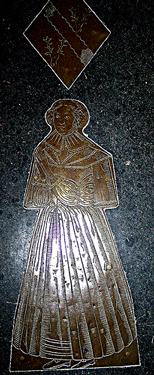 |
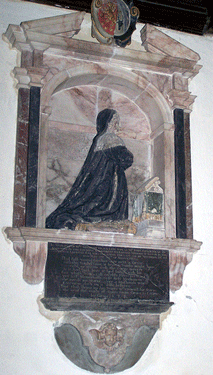 |
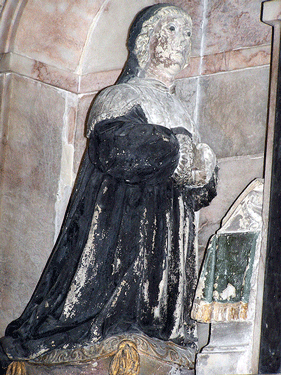 |
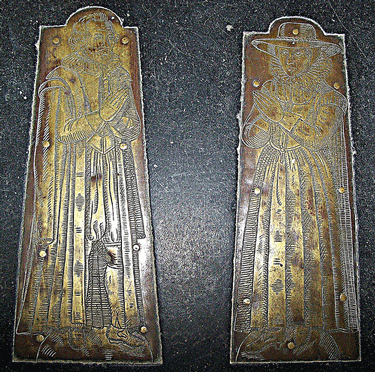 |
| Far left: 'Here lyes
Mrs Mary Nedham,youngest daughter of Mr Edward
Needham, of Ilston in the countyr of Leicester, Esq., who was
borne upon Friday the 22nd April, 1611, and dyed upon Friday,
the 16th day of January, 1628' Centre Left and Right: Millicent Grace 1633, daughter of Edward Needham of Ilston and wife of John Grace the Vicar. 'She went the road of saints from grace to glorie' Far Right: 'Here lyeth Edward Kent, Gent...and Joane his wife...He aged 83 years died ye first of May 1624, ahe aged 79 years died the last of February the same year leaving behind good fames of Hospitalyty and other virtues |
|||
|
Eaton Hastings St Michael |
Shrivenham - St Andrew | |
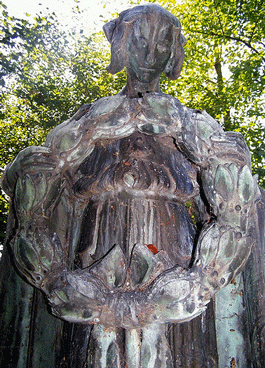 |
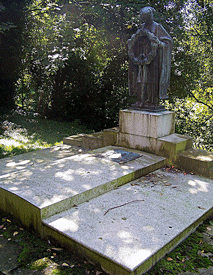
 Alexander Henderson, 1st Baron Farringdon (1934). Figure is by George Frampton. There is no actual village to go with the church. The monument is in the church yard. |
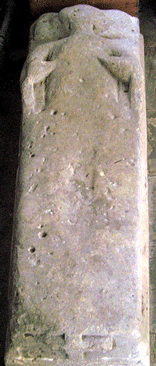 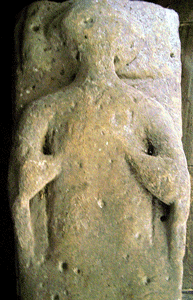
Lady 14th century
|
|
Hatford St George |
|||

Civilian late 13th century
|
 |
Fyfield - St Nicholas |
 |
| Park outside the church around the green. On my last visit the church was unfortunately locked but we found a helpful key holder in the house opposite the church. The church was damaged by a fire in 1893 and later restored, which accounts for the damaged state of the monuments. O/S Ref: SU 424 989 |
 |
 |
 |
|
Sir John Golafre (1442) Effigy in armour above and partly shrouded corpse below |
 |
|
 |
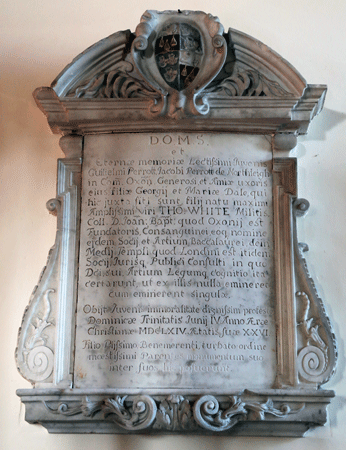 |
 |
| Cartouche unknown: heraldy only | Tablet to Thomas White (1664) Close examination of the lettering (below) reveals that the letterer made an unfortunate error, missing out the 't' in immortal to produce immoral. The missing letter, as can be seen, was added later. We do not know if he was paid! | George Dale (1625). Incised bust with skull. Much of the lettering badly damaged. |
 |
 |
||
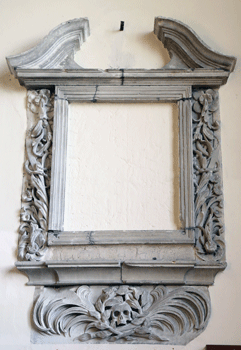 |
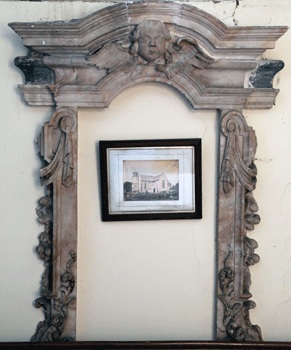 |
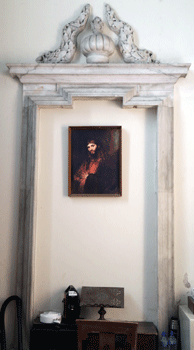 |
|
|
Above Top: Thomas White detail. Above Bottom: Damaged tablets (17th to 18th centuries) partly used a picture frames. Far Right: Lady Katherine Gordon (1527) 'The White Rose of Scotland'. Widow of the pretender to the English throne, Perkin Warbeck, who was executed in 1499. Outlines of brasses and their attachements can be made out on the back wall. |
|||
| Hurley - St Mary | Uffington - St Mary | ||
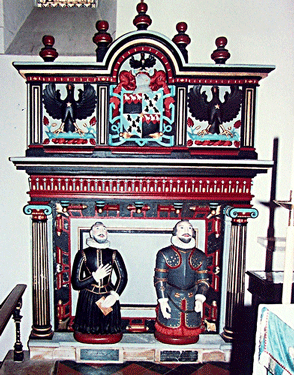 Richard Lovelace (1602) and his son Sir Richard, 1st Baron Lovelace (1634). These figures, of which remain the upper parts only, are from a lost monument and now rest in the monument to John Lovelace (1558) and his Wife (1597) Photograph by Dennis Hilliard |
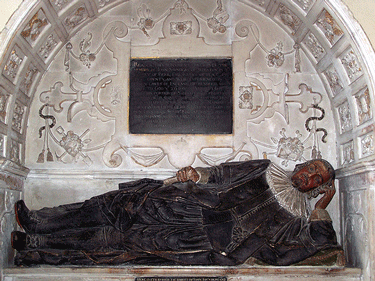 Above: John Saunders JP (1638) barrister '...this portion of sacred earth preserves his body which is sequested for ye resurrection...' Right\; Tom Hughes QC (1896) sometimes MP, judge and author of Tom Brown's Schooldays written for his eldest son who was about to go to boarding school. |
 |
|
| Hungerford - St Lawrence | ||
| Church is early Victorian. Opening not known. Park in one of the town's car parks | ||
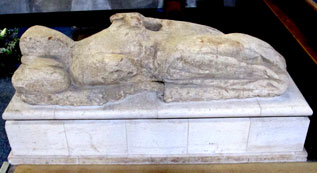 |
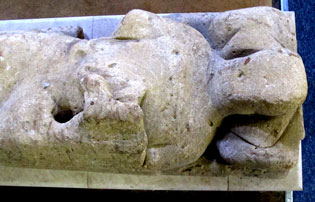 |
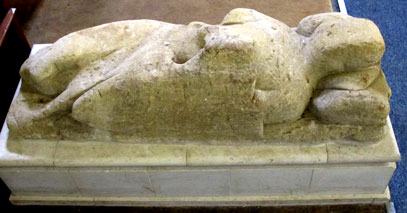 |
| Unknown knight c. 1350 | ||
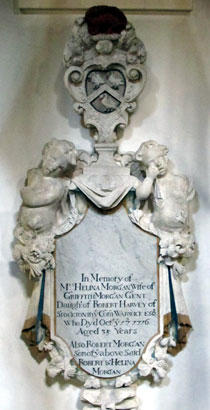 |
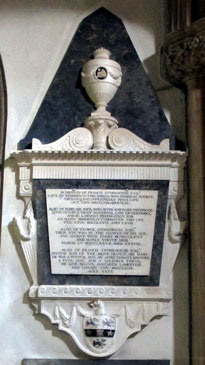 |
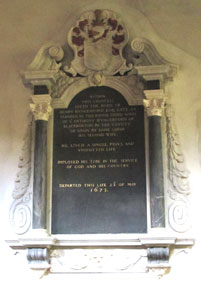 |
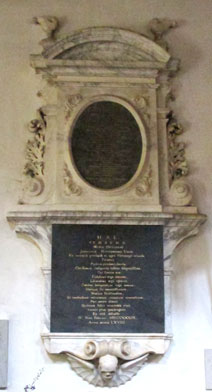 |
| Faringdon - All Saints | |
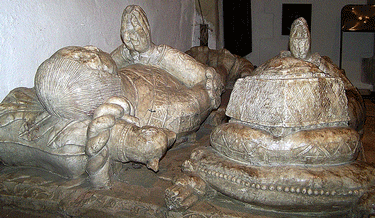 |
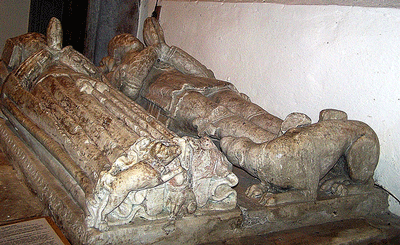 |
|
Sir Thomas Unton (1533) and his first wife Elizabeth (Yonge) (1487) He wears the SS collar and tabard on which quartered arms of Unton impaling Yonge. Alabaster |
|
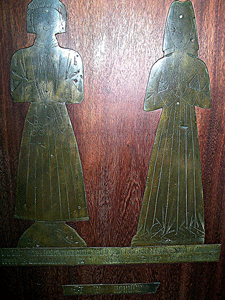 |
 |
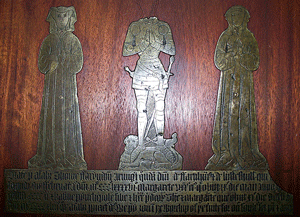
Brasses:
Left: John (1485) & Margaret Parker Centre: John Sadler (1505) Vicar of Inglesham Above: Thomas (1396) & Margaret Faryndun (1402) with daughter Katherine Pynchepole (1443) |
 Above: Sir Alexander Unton (1547), Mary (Bouchier) and Lady Cecyll (Bulstrode) Brasses set in back wall of Purbeck marble monument. Centre: Widow of Sir Henry Unton (1596): remaining fragment of destroyed monument Right: Tobias Pleydell (1563) and his wife Eleanor |
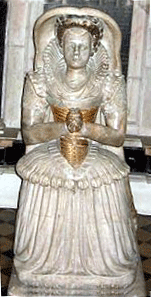 |
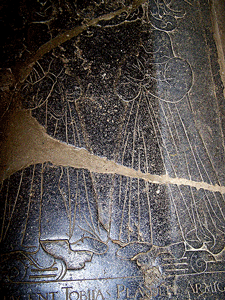 |
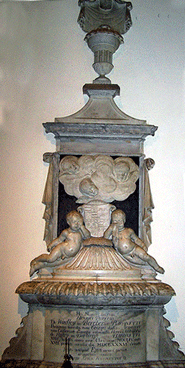 |
 Left: Sir Henry Purefoy Bt Above & right: Vice Admiral Thomas Pye (The monument is dedicated to his father Henry (1749) but shows and portrait of Thomas. |
 |
| Kintbury - St Mary | ||||||
 |
 |
|
||||
| Martha Butler (1873) | Margaret Duncan (1890) | |||||
|
|
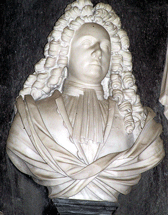 |
Shellingford St Faith |
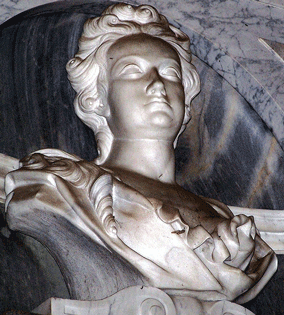 |
| Left:
Sir Edward Hannes (1710) Physician to Queen
Anne. Pupil of Westminster School, to which he left money for a
new dormitory and drinking goblet to the Queen's Scholars. Below: William Viscount Ashbrook (1780) signed William Tyler of Bath white, gray and brown marbles Right: Mary Packer (1719) She inherited the manor of Little Shefford from her sister. white and gray marbles |
||
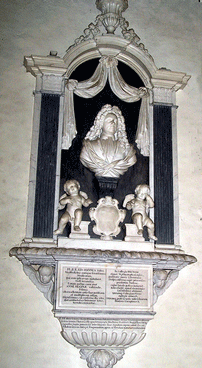 |
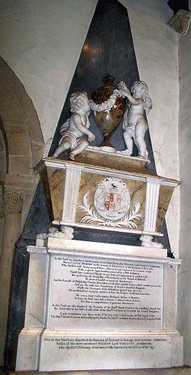 |
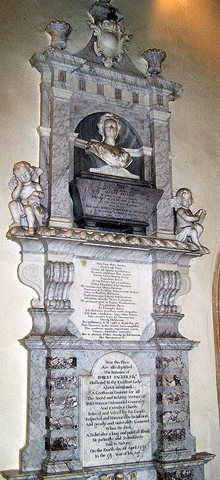 |
 |
Sparsholt - Holy Cross |
 |
| The church is open during day. Park in village near church O/S Ref: SU 347 876 |
| Chancel - Medieval Effigies |
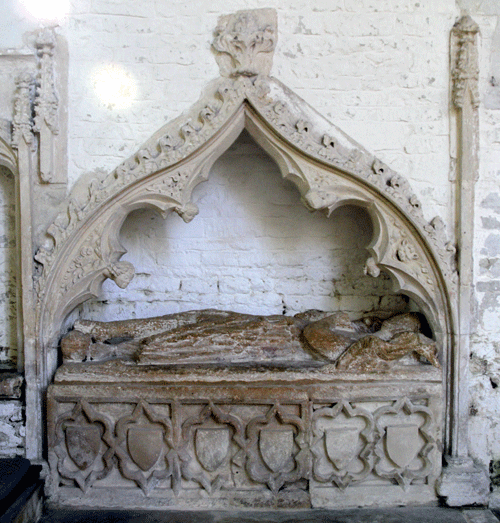 |
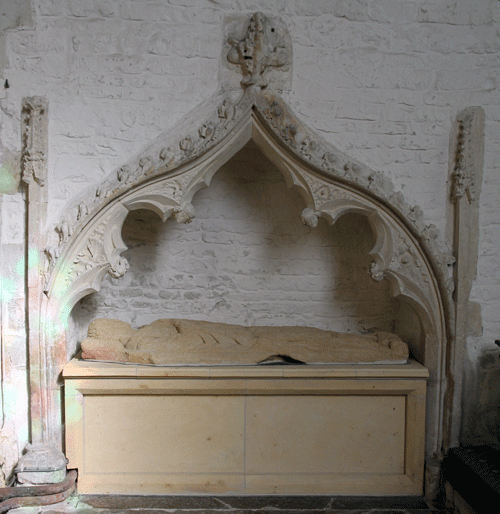 |
 |
 |
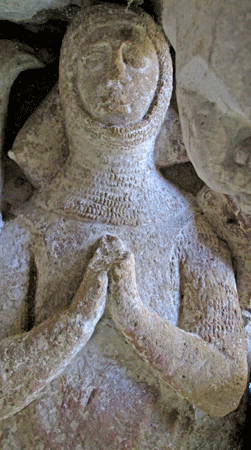 |
.png) |
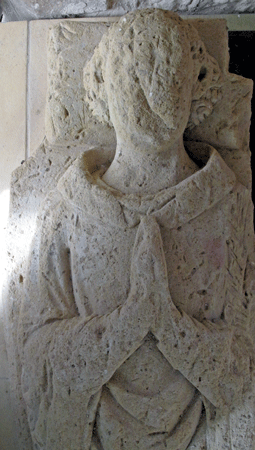 |
| Robert Achard (c1298) | Adam Achard (c1221) Rector |
| Chapel - Medieval Effigies |
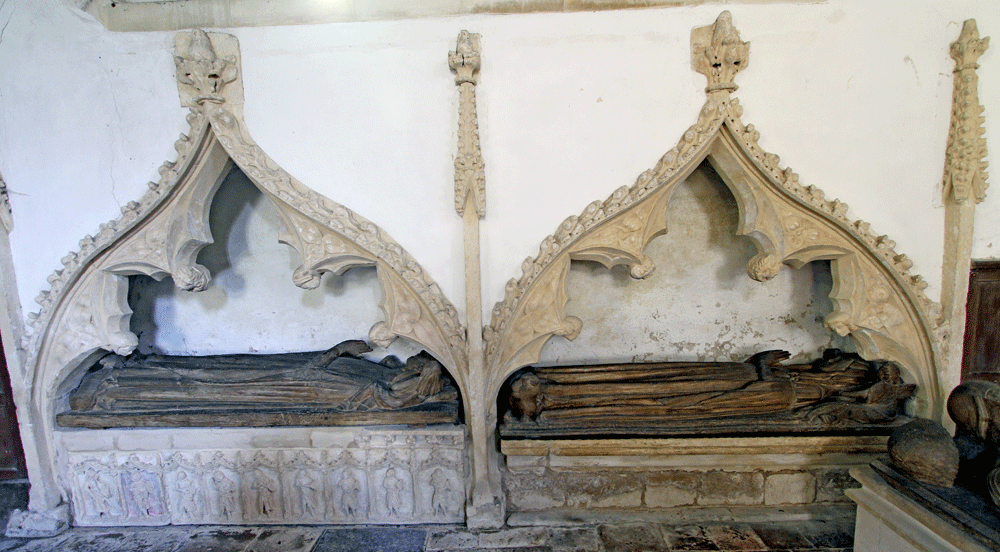 |
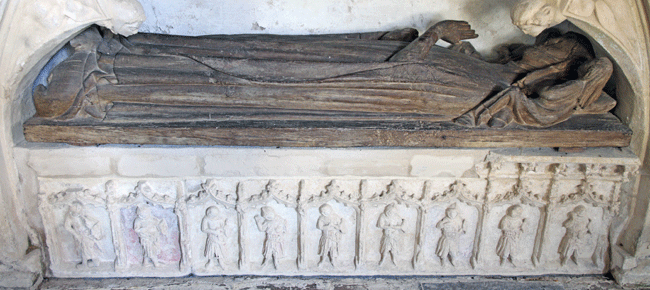 Three wooden effigies said to be of Sir Robert Achard (1353) and his two wives: Joanna (1336) and Agnes (1365) Joanna is one the left and the slightly damaged one but which lies on a tomb chest with figures; Agnes is on the right, more complete but modern tomb chest, and of whom the etching by the Hollises is shown. Details of the effigies are to be found below |
 |
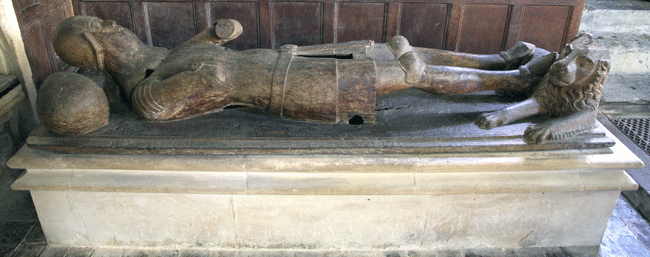 |
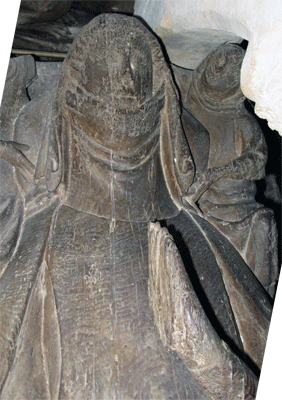  |
 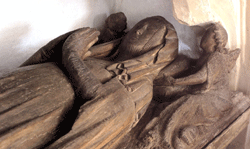 |
.png) |
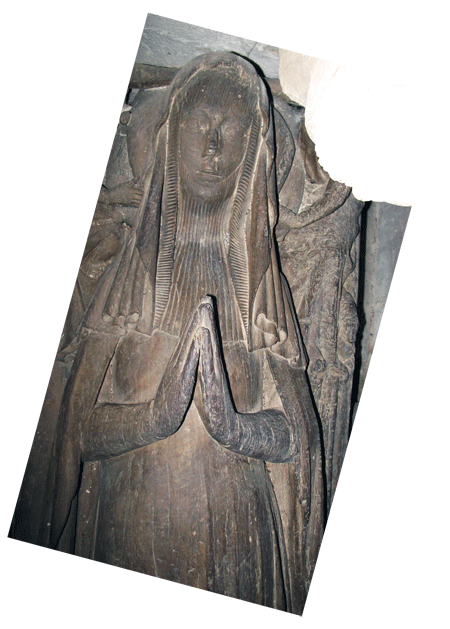 |
| Brasses |
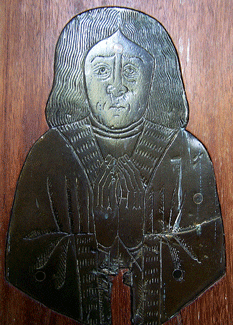
Thomas Bothe (c 1495)
|

William de Herleston (1353)
Rector 1312-1342 when
advowson was sold to Queen's College, Oxford; thereafter
vicar
|
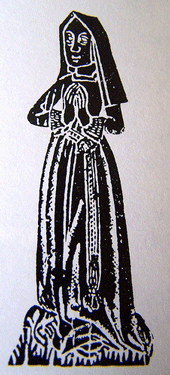
Unknown c 1510
|

John Fettiplace (c 1602)
|
| Tablets | Church Yard | ||||||
|
|
||||||
| Wantage - St Peter and St Paul |
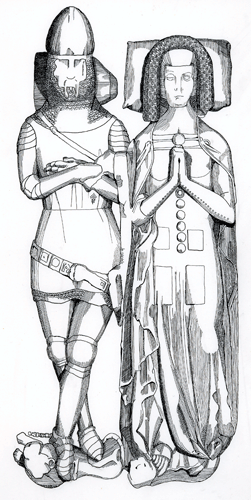 |
 |
|
| Sir William FitzWarren
(1361)
& Amicia
Alabaster
of 1330-65. Note Fitzwarren arms on jupon. Legs are crossed -
unusual for this date. (shown - photograph & drawing) Sir IvesFitzwarren (1414) brass Priest (1330) brass Male Civilian (early 16th century) brass Walter Talbot (1522) & Two Wives brass William Wilmot (1684) Tablet with columns and pediment, supported on three angel busts Two frontal demi-figures with a baby upright between them. By William Bird of Oxford. John Stamp (1728) & Wife (1741) by John Townsend Jnr |
I produced the drawings on this page (and elsewhere on the site) with technical pens on CS10 paper, which was made by Frisk. This was almost magical paper for you could scratch the surface and still draw on the scratched away part below: in fact, it was in effect all surface. This had two very useful purposes. If you made a mistake after several hours drawing - or, and even more frustrating, if one of those temperamental technical pens decided to produce a blot - you could scratch away the unwanted ink with a scalpel and leave a clean, useable surface underneath. Even better you could partly scratch away wanted ink so giving a less intense lines, producing an effect rather like 'stopping out' gives in the etching process.
Frisk unfortunately ceased production of this paper several years ago and I have been unable to find a similar paper anywhere; it is highly likely that none exists.


.png)
